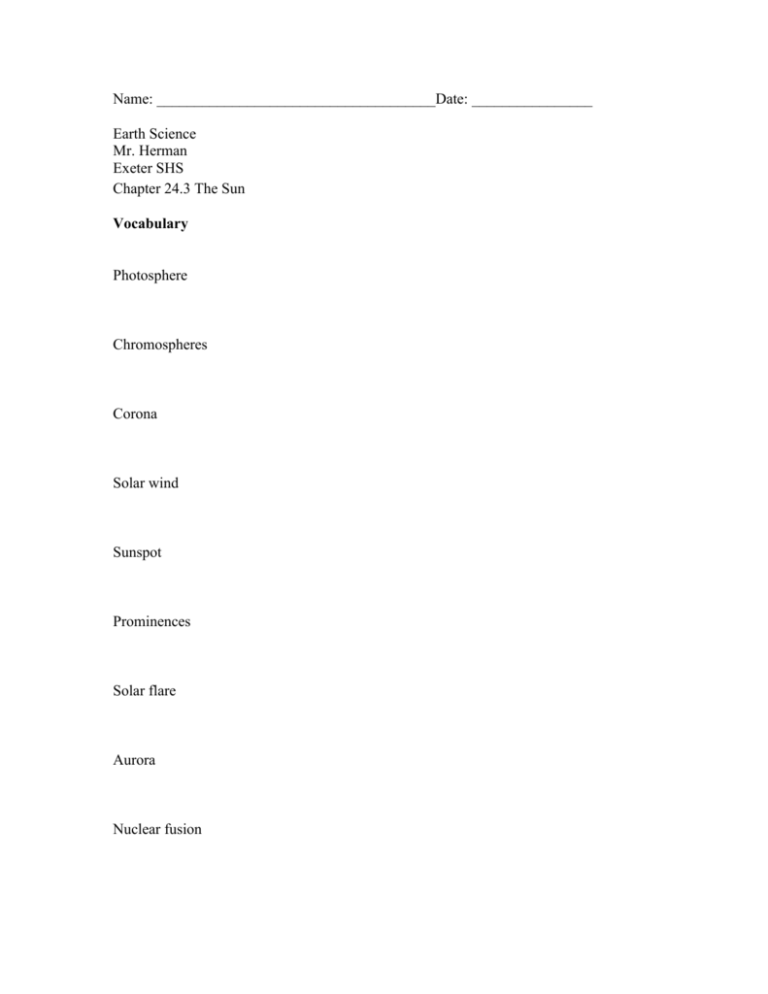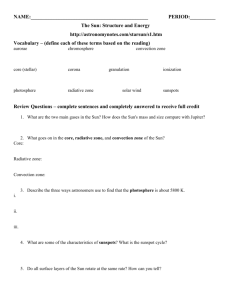Section 24.3 The Sun
advertisement

Name: _____________________________________Date: ________________ Earth Science Mr. Herman Exeter SHS Chapter 24.3 The Sun Vocabulary Photosphere Chromospheres Corona Solar wind Sunspot Prominences Solar flare Aurora Nuclear fusion Questions for discussion What are the 4 parts of the Sun? Draw and Label the Sun Why do sunspots appear dark? What forms of energy is released by solar flares? What is fusion? (Use helium and hydrogen in your explanation) Objective Structure of the Sun Because the sun is made of gas, no sharp boundaries exist between its various layers. Keeping this in mind, we can divide the sun into four parts: the solar interior; the visible surface, or photosphere; and two atmospheric layers, the chromosphere and corona. Photosphere The photosphere is the region of the sun that radiates energy to space, or the visible surface of the sun. It consists of a layer of incandescent gas less than 500 kilometers thick. It exhibits a grainy texture made up of many small, bright markings, called granules, produced by convection. Most of the elements found on Earth also occur on the sun. Its temperature averages approximately 6000 K (10,000ºF). Chromosphere The chromosphere is the first layer of the solar atmosphere found directly above the photosphere. It is a relatively thin, hot layer of incandescent gases a few thousand kilometers thick. Its top contains numerous spicules, which are narrow jets of rising material. Corona The corona is the outer, weak layer of the solar atmosphere. The temperature at the top of the corona exceeds 1 million K. Solar wind is a stream of protons and electrons ejected at high speed from the solar corona. The Active Sun Sunspots A sunspot is a dark spot on the sun that is cool in contrast to the surrounding photosphere. Sunspots appear dark because of their temperature, which is about 1500 K less than that of the surrounding solar surface. Prominences Prominences are huge cloudlike structures consisting of chromospheric gases. Prominences are ionized gases trapped by magnetic fields that extend from regions of intense solar activity. Solar Flares Solar flares are brief outbursts that normally last about an hour and appear as a sudden brightening of the region above a sunspot cluster. During their existence, solar flares release enormous amounts of energy, much of it in the form of ultraviolet, radio, and X-ray radiation. Auroras, the result of solar flares, are bright displays of ever-changing light caused by solar radiation interacting with the upper atmosphere in the region of the poles. Aurora Borealis The Solar Interior Nuclear Fusion Nuclear fusion is the way that the sun produces energy. This reaction converts four hydrogen nuclei into the nucleus of a helium atom, releasing a tremendous amount of energy. During nuclear fusion, energy is released because some matter is actually converted to energy. It is thought that a star the size of the sun can exist in its present stable state for 10 billion years. As the sun is already 4.5 billion years old, it is “middle-aged.” Nuclear Fission








